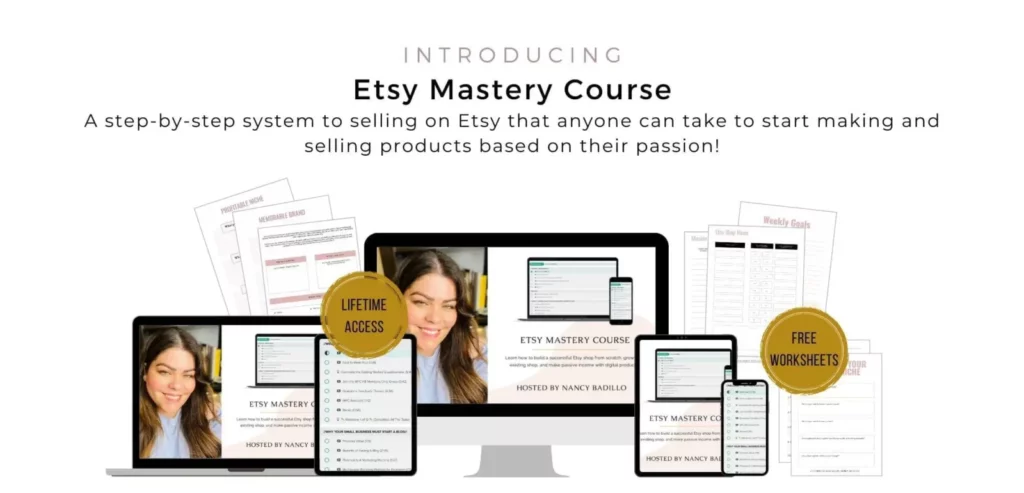Looking to showcase your creativity and sell your unique crafts online? Look no further than the world of online marketplaces like Etsy. While Etsy may be the first name that comes to mind, there are actually a plethora of other sites that offer a similar platform for artists, crafters, and makers to connect with buyers from all around the world. These alternative sites not only provide a convenient way to sell your products, but they also offer a supportive community and a chance to reach a wider audience.
Whether you’re a seasoned seller or just getting started, exploring other online marketplaces can open up new opportunities for your business. From handmade goods to vintage treasures, these platforms cater to a variety of niche markets, making it easier for you to find the perfect audience for your products. So, let’s dive into the world of alternative sites like Etsy and discover the possibilities that await!

This blog post is all about alternatives sites like Etsy.
Home > Etsy Biz > Sites Like Etsy
DISCLOSURE: This is a sponsored post. Through my links, I may receive a commission if you decide to make purchases at no cost for yourself! Check out our disclaimer for more info on how it works.
Ready to embark on your Etsy business journey but unsure of where to begin? Join our free masterclass, where we empower you to start, manage, and scale your Etsy business into a full-time income. With our guidance, 9,000+ individuals have found success, even without a social media presence or email list. Step into the world of Etsy entrepreneurship, and let us guide you to success. Join us now!
Table of contents
- Comparison of different sites like Etsy – eBay, Amazon Handmade, and Shopify
- Choosing the right platform for your online business
- Setting up your shop on Etsy and other similar sites
- Optimizing your product listings for better visibility and sales
- Promoting your shop on Etsy and other similar sites
- Final Thoughts: Sites Like Etsy
- Ready To Start An Etsy Business?
- New On The Blog
Comparison of different sites like Etsy – eBay, Amazon Handmade, and Shopify
While Etsy may be the go-to platform for many artists and crafters, it’s worth exploring other sites that offer similar opportunities to sell your products. Let’s take a closer look at some of the top alternatives to Etsy and how they compare.
1. eBay: Known primarily as an auction site, eBay also offers a marketplace for handmade and unique items. It has a large user base and a wide range of product categories, making it a great platform for reaching a diverse audience. However, unlike Etsy, eBay allows for both new and used items, which means you may face more competition and pricing challenges. Additionally, eBay charges fees for listing and selling items, which may impact your profit margins.
2. Amazon Handmade: As one of the largest online marketplaces, Amazon has entered the handmade market with Amazon Handmade. This platform provides a vast customer base and offers the convenience of Prime shipping for eligible products. However, Amazon Handmade requires sellers to apply and be approved before they can list their products, ensuring that only genuinely handmade items are featured. While Amazon Handmade can provide significant exposure, it may be more competitive and challenging to stand out among the vast array of products available.
3. Shopify: Unlike Etsy, eBay, and Amazon Handmade, Shopify is not a marketplace itself. Instead, it is an e-commerce platform that allows you to create your own online store. This gives you more control over your brand and the customer experience. You can customize your shop’s appearance, set your own pricing, and have greater flexibility in terms of marketing and promotions. However, setting up and managing your own Shopify store requires more technical expertise and ongoing maintenance. Additionally, you’ll need to drive traffic to your store independently, as Shopify does not have an existing customer base like Etsy or eBay.
When choosing the right platform for your online business, consider factors such as your target audience, product niche, competition, fees, and the level of control you desire over your brand. Each platform has its own strengths and weaknesses, so it’s important to evaluate them based on your specific needs and goals.
Choosing the right platform for your online business
When it comes to choosing the right platform for your online business, there are several factors to consider. Here are some key considerations to help you make an informed decision:
1. Target audience: Think about the audience you want to reach with your products. Different platforms attract different types of buyers. Etsy, for example, is known for its focus on handmade, unique, and vintage items. eBay, on the other hand, has a broader range of product categories and attracts a wider audience. Consider which platform aligns best with your target audience and the type of products you sell.
2. Product niche: Consider the niche market you cater to. Some platforms, like Etsy and Amazon Handmade, have a specific focus on handmade and unique items. Others, like eBay and Shopify, allow for a broader range of products. If your products fall into a specific niche, you may find it more beneficial to choose a platform that caters specifically to that market.
3. Competition: Assess the level of competition on each platform. Some platforms may have a higher number of sellers in your product category, making it more challenging to stand out. Research the competition and evaluate how saturated the market is for your specific products. Look for platforms where you can differentiate yourself and have a higher chance of getting noticed by potential buyers.
4. Fees: Consider the fees associated with each platform. Some platforms charge listing fees, transaction fees, or monthly subscription fees. Calculate the costs involved in selling on each platform and evaluate how they align with your profit margins. It’s important to strike a balance between the fees and the potential benefits and exposure each platform offers.
5. Brand control: Evaluate how much control you want over your brand and the customer experience. Platforms like Etsy and Amazon Handmade provide a ready-made marketplace with a built-in customer base. However, you may have less control over the branding and customization of your shop. On the other hand, platforms like Shopify allow you to create your own online store, giving you complete control over your brand and the customer experience.
By considering these factors, you can choose the platform that best aligns with your business goals and target audience. Remember, it’s not just about finding the most popular platform, but rather finding the one that offers the right balance of exposure, competition, fees, and brand control for your specific business.
Setting up your shop on Etsy and other similar sites
Setting up your shop on Etsy and other similar sites is a relatively straightforward process. Here are the steps to get started:
1. Create an account: Begin by creating an account on the platform of your choice. Provide the required information, such as your name, email address, and password. Some platforms may require additional verification steps, such as confirming your identity or linking a bank account for payment processing.
2. Choose a shop name: Select a unique and memorable name for your shop. This will be your online identity and will help buyers recognize your brand. Consider a name that reflects your products or the niche market you cater to. Ensure that the name is not already in use by another seller on the platform.
3. Set up your shop profile: Fill out your shop profile with relevant information about your business. This includes a description of your shop, your story, and any policies or terms of service you have. Use this space to showcase your brand’s personality and connect with potential buyers.
4. Add product listings: Start adding your products to your shop. Each platform will have specific guidelines on how to create product listings. Include high-quality photos, detailed descriptions, and relevant tags or keywords to optimize your listings for search visibility. Consider using keywords that buyers are likely to search for when looking for products like yours.
5. Pricing and shipping: Determine your pricing strategy and set the prices for your products. Consider factors such as the cost of materials, the time and effort invested in creating the product, and the market demand. Additionally, decide on your shipping options and rates. Consider offering free shipping or flat-rate shipping to attract buyers.
6. Payment processing: Set up your payment processing options. Most platforms offer secure payment gateways to handle transactions. Ensure that you link your bank account or payment processor to receive payments from buyers. Test the payment process to ensure it is working smoothly.
7. Policies and terms: Define your policies and terms of service. This includes policies on returns, exchanges, refunds, and any other relevant guidelines. Be transparent and clear about your policies to manage buyer expectations and avoid disputes.
8. Launch your shop: Once you have completed the setup process, it’s time to launch your shop. Promote your shop through social media, your website (if you have one), and other marketing channels to drive traffic and attract buyers.
Remember, each platform may have specific requirements and guidelines for setting up your shop. Take the time to familiarize yourself with the platform’s resources and support documentation to ensure you optimize your shop’s setup and maximize your chances of success.
Optimizing your product listings for better visibility and sales
Optimizing your product listings is essential for better visibility and increased sales on platforms like Etsy and other similar sites. Here are some tips to help you optimize your product listings:
1. Use high-quality photos: Invest in high-quality product photos that showcase your items in the best possible light. Ensure that the photos are well-lit, clear, and accurately represent your products. Consider using multiple angles and close-up shots to highlight the details. Avoid using stock photos and instead, showcase the actual products you are selling.
2. Write compelling descriptions: Craft compelling and informative descriptions for your products. Use persuasive language to highlight the unique features, benefits, and craftsmanship of your items. Be specific and detailed, providing measurements, materials used, and any other relevant information that can help buyers make an informed decision. Use keywords naturally throughout your descriptions to improve search visibility.
3. Optimize your titles and tags: Pay attention to your product titles and tags. Use descriptive and keyword-rich titles that accurately represent your products. Incorporate relevant keywords that buyers are likely to search for when looking for products like yours. Additionally, use relevant tags that describe your items and make them more discoverable in search results.
4. Offer variations and customization: If applicable, offer variations or customization options for your products. This allows buyers to choose the specific options that suit their preferences. For example, if you sell handmade jewelry, offer different sizes, colors, or materials. Providing customization options can attract more buyers and increase the chances of making a sale.
5. Highlight reviews and ratings: If you have positive reviews and ratings from previous buyers, showcase them in your product listings. Testimonials and social proof can build trust and confidence in potential buyers. Consider featuring snippets of reviews or displaying your overall rating prominently to encourage trust and credibility.
6. Price competitively: Research the pricing of similar products on the platform and set your prices competitively. Consider factors such as the cost of materials, labor, and overhead expenses when determining your pricing. Avoid overpricing or underpricing your products, as both can negatively impact sales. Strike a balance between offering value to buyers and ensuring you make a profit.
7. Update and refresh listings: Regularly update and refresh your product listings to keep them relevant and enhance visibility. Refreshing your listings can improve their ranking in search results and attract more buyers. Consider updating product photos, descriptions, titles, or tags to keep your listings current and appealing.
Remember, optimizing your product listings is an ongoing process. Continuously monitor your listings’ performance, track keywords, and make adjustments based on buyer feedback and market trends. By optimizing your listings, you can improve visibility, attract more buyers, and increase your sales on platforms like Etsy and other similar sites.
Promoting your shop on Etsy and other similar sites
Promoting your shop on Etsy and other similar sites is crucial for attracting buyers and increasing your sales. Here are some effective strategies to promote your shop:
1. Social media marketing: Leverage the power of social media to promote your shop and products. Create accounts on platforms like Instagram, Facebook, Pinterest, or Twitter, and showcase your products through visually appealing posts. Use relevant hashtags, engage with your followers, and collaborate with influencers or bloggers in your niche to reach a wider audience. Consider running targeted ads or promotions on social media to drive traffic to your shop.
2. Search engine optimization (SEO): Optimize your shop and product listings for search engines. Research relevant keywords and incorporate them naturally in your titles, descriptions, and tags. Use keyword-rich headings, alt text for images, and relevant meta descriptions. This will improve your shop’s visibility in search results and attract organic traffic from search engines like Google.
3. Email marketing: Build an email list of interested buyers and potential customers. Offer incentives such as exclusive discounts, early access to new products, or freebies in exchange for their email addresses. Send regular newsletters or promotional emails to keep your audience engaged and informed about new products, sales, or special offers. Personalize your emails to make them more relevant and compelling.
4. Collaborations and partnerships: Collaborate with other sellers, influencers, or complementary businesses to cross-promote each other’s products. This can help you tap into new audiences and gain exposure to potential buyers who may not be aware of your shop. Consider partnering for giveaways, guest blog posts, or joint social media campaigns to reach a wider audience and increase brand visibility.
5. Paid advertising: Consider investing in paid advertising to promote your shop. Many platforms, including Etsy, offer advertising options that allow you to showcase your products to a targeted audience. Set a budget, define your target audience, and create compelling ads that drive traffic to your shop. Monitor the performance of your ads and make adjustments based on the results.
6. Content marketing: Create valuable and informative content related to your products or niche. This can include blog posts, tutorials, DIY guides, or videos. Share this content on your website, social media, or through guest blogging opportunities. By providing valuable content, you position yourself as an expert in your field and attract potential buyers who are interested in your products.
7. Participate in online communities: Engage with online communities, forums, or Facebook groups that are relevant to your niche. Provide helpful advice, answer questions, and share your expertise. Avoid direct promotion but include your shop’s link in your profile or signature.
Final Thoughts: Sites Like Etsy
In conclusion, the world of online marketplaces offers a plethora of options for those seeking unique and handcrafted treasures. While Etsy may be the go-to platform for many, it’s important to explore alternative sites that cater to different niches and offer distinct experiences. Whether you’re looking for vintage finds, specialized crafts, or artistic creations, there are various platforms waiting to be discovered. So, broaden your horizons and venture into the realm of different sites like Etsy to uncover hidden gems and support independent sellers worldwide. Happy shopping!
Ready To Start An Etsy Business?
If you’re considering starting your own Etsy store but unsure about which products to offer, my signature course, the Etsy Mastery Course, is your ultimate guide. Learn how to start, manage, and scale your Etsy business to a full-time income.

New On The Blog
- Understanding Essential Requirements Before Starting Your Business: A Comprehensive Guide
- Trends on Etsy: What’s Hot and How to Find the Best-Selling Products
- Most Popular Etsy Product Categories
- Ultimate Review of the eRank Free vs Pro Plans
- How to Make SVGs to Sell on Etsy: A Beginner’s Guide
- Top Christmas Cricut Crafts to Sell for Extra Holiday Cash

+ show Comments
- Hide Comments
add a comment